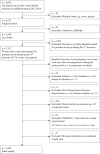Magnitude and determinants of inadequate third-trimester weight gain in rural Bangladesh
- PMID: 29698483
- PMCID: PMC5919629
- DOI: 10.1371/journal.pone.0196190
Magnitude and determinants of inadequate third-trimester weight gain in rural Bangladesh
Abstract
Objectives: The objective of this study was to estimate the magnitude and determinants of inadequate weight gain in the third-trimester among rural women in Matlab, Bangladesh.
Methods: The study analyzed data on weight gain in the third trimester in 1,883 pregnant women in Matlab, Bangladesh. All these women were admitted to Matlab hospital of the International Centre for Diarrhoeal Disease Research, Bangladesh (icddr,b) for childbirth during 2012-2014, and they had singleton live births at term. Data were retrieved from the electronic databases of Matlab Health and Demographic Surveillance System and Matlab hospital. A multivariable logistic regression for inadequate weight gain in the third trimester (≤4 kg) was built with sociodemographic, environmental and maternal factors as predictors.
Results: One thousand and twenty-six (54%) pregnant women had inadequate weight gain in the third trimester. In the multivariable model, short stature turned out to be the most robust risk factor for inadequate weight gain in the third trimester (OR = 2.5; 95% CI 1.8, 3.5 for short compared to tall women). Pre-third-trimester BMI was inversely associated with insufficient weight gain (OR = 0.96; 95% CI 0.93, 0.99 for 1 unit increase in BMI). Other risk factors for inadequate weight gain in the third trimester were advanced age (OR = 1.9; 95% CI 1.2, 3.1 for ≥35 years compared to ≤19 years), parity (OR = 1.5; 95% CI 1.2, 1.9 for multipara compared to nulliparous women), low socioeconomic status (OR = 1.7; 95% CI 1.2, 2.3 for women in the lowest compared to women in the highest wealth quintile), low level of education (OR = 1.6; 95% CI 1.2, 2.1 for ≤5 years compared to ≥10 years of education), belonging to the Hindu religious community (OR = 1.8; 95% CI 1.3, 2.5), consuming arsenic-contaminated water (OR = 1.4; 95% CI 1.1, 1.9), and conceiving during monsoon or dry season compared to summer (OR = 1.4; 95% CI 1.1, 1.8).
Conclusions: Among rural Bangladeshi women in Matlab, third-trimester weight gain was in general poor. Maternal characteristics such as short stature, low BMI, advanced age, parity, low level of education and socioeconomic status, being Hindu, intake of arsenic contaminated water, and conceiving during monsoon or dry season were the risk factors for inadequate weight gain in the third trimester. Special attention should be given during prenatal care to women with the risk factors identified in this study.
Conflict of interest statement
Figures
Similar articles
-
Inadequate maternal weight gain in the third trimester increases the risk of intrauterine growth restriction in rural Bangladesh.PLoS One. 2019 Feb 8;14(2):e0212116. doi: 10.1371/journal.pone.0212116. eCollection 2019. PLoS One. 2019. PMID: 30735555 Free PMC article.
-
Effect of Maternal Exposure to Seasons during the Second and Third Trimesters of Pregnancy on Infant Birth Weight in Rural Bangladesh.Curr Dev Nutr. 2020 Feb 4;4(3):nzaa016. doi: 10.1093/cdn/nzaa016. eCollection 2020 Mar. Curr Dev Nutr. 2020. PMID: 32154502 Free PMC article.
-
Chronic energy deficiency in women from rural Bangladesh: some socioeconomic determinants.J Biosoc Sci. 1998 Jul;30(3):349-58. doi: 10.1017/s0021932098003496. J Biosoc Sci. 1998. PMID: 9746833
-
Nutrition and nutritional status of rural women in East Java.Trop Geogr Med. 1979 Dec;31(4):571-85. Trop Geogr Med. 1979. PMID: 542993
-
Biological determinants of pregnancy weight gain in a Filipino population.Am J Clin Nutr. 1993 Mar;57(3):365-72. doi: 10.1093/ajcn/57.3.365. Am J Clin Nutr. 1993. PMID: 8438770
Cited by
-
Determinants of Suboptimal Gestational Weight Gain among Antenatal Women Residing in the Highest Gross Domestic Product (GDP) Region of Malaysia.Nutrients. 2022 Mar 30;14(7):1436. doi: 10.3390/nu14071436. Nutrients. 2022. PMID: 35406049 Free PMC article.
-
Inadequate maternal weight gain in the third trimester increases the risk of intrauterine growth restriction in rural Bangladesh.PLoS One. 2019 Feb 8;14(2):e0212116. doi: 10.1371/journal.pone.0212116. eCollection 2019. PLoS One. 2019. PMID: 30735555 Free PMC article.
-
Impact of Pre-Gestational BMI and Gestational Weight Gain on Fetal Development Outcomes in Adolescent Pregnant Women.J Clin Med. 2024 Mar 22;13(7):1839. doi: 10.3390/jcm13071839. J Clin Med. 2024. PMID: 38610604 Free PMC article.
-
Gestational weight gain at the national, regional, and income group levels based on 234 national household surveys from 70 low-income and middle-income countries.PLOS Glob Public Health. 2024 Sep 4;4(9):e0003484. doi: 10.1371/journal.pgph.0003484. eCollection 2024. PLOS Glob Public Health. 2024. PMID: 39231104 Free PMC article.
-
Association of Household Food Insecurity with Nutritional Status and Mental Health of Pregnant Women in Rural Bangladesh.Nutrients. 2021 Nov 28;13(12):4303. doi: 10.3390/nu13124303. Nutrients. 2021. PMID: 34959855 Free PMC article.
References
-
- IOM (Institute of Medicine), & NRC (National Research Council). Weight gain during pregnancy: Reexamining the guidelines In: Rasmussen KM, Yaktine AL, editors. Washington (DC): The National Academies Press (US); 2009. - PubMed
-
- Pitkin RM. Nutritional influences during pregnancy. Med Clin North Am. 1977;61(1):3–15. - PubMed
-
- King JC, Bronstein MN, Fitch WL, Weininger J. Nutrient utilization during pregnancy Energy Nutrition of Women. 52: Karger Publishers; 1987. p. 71–142. - PubMed
-
- Picciano MF. Pregnancy and lactation: physiological adjustments, nutritional requirements and the role of dietary supplements. J Nutr. 2003;133(6):1997s–2002s. Epub 2003/05/29. doi: 10.1093/jn/133.6.1997S . - DOI - PubMed
-
- Hediger ML, Scholl TO, Belsky DH, Ances IG, Salmon RW. Patterns of weight gain in adolescent pregnancy: effects on birth weight and preterm delivery. Obstet Gynecol. 1989;74(1):6–12. Epub 1989/07/01. PubMed . - PubMed
Publication types
MeSH terms
LinkOut - more resources
Full Text Sources
Other Literature Sources
Medical


